 Distances
to the most important places of tourist interest: Distances
to the most important places of tourist interest:
- PARTANNA: Km 6;
Medieval castle, Matrix and remains
of Neolithic hydraulic works (contrada Stretto)
- CASTELVETRANO: city of oil Km 9;
Civic Museum, baroque Churches,
Theater
- SELINUNTE: Km 10;
Archaeological parks, nature
reserve “Foce del Belice”, beach
- ACQUE PIE: Km. 15;
Source of thermal water
(hot thermal water swimming pool)
- CAVE DI CUSA: Km 20;
archaeological site
- SEGESTA: Km 40; ERICE: Km 90; TRAPANI:
Km 80; MARSALA, Mothia and salt pans: Km 70;
- AGRIGENTOand the Valley of Temples: 100 Km.
SOME OF TOURIST SITES
WORTH VISITING
 Selinunte Selinunte
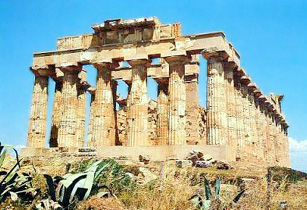 Founded
by colonists from Mengara Founded
by colonists from Mengara
Hyblaea during the second half the VII century B.C. the city first sided
with Carthage and then with Syracuse; after two centuries of prosperity
it was destroyed by Segesta with such violence that there are few
documented cases of similar violence in the ancient world. Razed to the
ground by Rome after the first Punic war, it suffered a progressive and
inexorable delay. Rediscovered and excavated during the 19th century, it
offers a scenery of great charm, especially when it isn’t crowded with
tourist. Worth visiting, in particular, is the acropolis where temple G
dedicated to Apollo, temple C to Afrodite, temple B and the buildings B
and O are dedicated to Castore and Pollice and temple F are to be found
the Sanctuary of Malophoros dedicated to Demetra is of great importance
and was for centuries the object of pilgrimage.
 The
EGADI Islands The
EGADI Islands
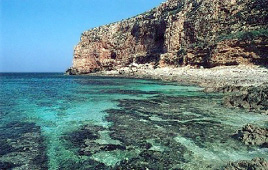 A group of island off the coast of Trapani, of great interest are their
crystal waters and their natural landscape which have recently been
declared a marine reserve.
A group of island off the coast of Trapani, of great interest are their
crystal waters and their natural landscape which have recently been
declared a marine reserve.
The main islands are Favignana, Levanzo and Marettimo. Favignana, the
biggest of the archipelago, has its roots in myth; here Ulysses and Enea
sailed, next came the Phoenicians decisive naval battles were fought in
its waters between the Romans and Carthaginians, which finished in favor
of Rome. Under the Spanish, Austrians and Bourbonists, it became the
ideal place for the isolation of prisoners. Its subsoil supplied the
building material with which entire Sicilian cities were built. Its
tonnara is of great importance for the “Mattanza” (capture of tuna fish)
. It is possible to visit the archaeological site of the Bagni Romani,
the baroque quarter of St Anna in the twon of Favignana, the buildings
of the tonnara and the splendid beaches, from Cala Azzurra to Lido
Burrone, from Stornello to Punta Sottile.
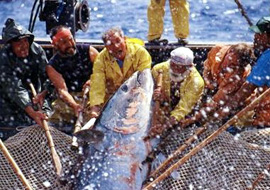 Marettimo,
the most eastern of the Egadi islands, can be described as a mountain
among the waves, a world where the in habitants haven't wanted hotels (although
they willingly give hospitality to tourists in their own homes) and
where the fishers have boats which recall the Viking boats. Spectacular
views of the landscape and contact with nature are to be enjoyed during
a stay on the island, as is a sail round the island to see and visit the
count less enchanting grottoes. Levanzo, where there are no roads, is
famous for the “Grotta del Genovese”, where between 5 to 10 thousand
years ago anonymous hands drewgraffiti representing men and animals,
thought by some to represent tuna fishing. At the time of the drawings
Levanzo and Favignana were still joined to the rest of Sicily . The
crystal clear water of Levanzo like that of the other two islands makes
it sought after by tourists. Marettimo,
the most eastern of the Egadi islands, can be described as a mountain
among the waves, a world where the in habitants haven't wanted hotels (although
they willingly give hospitality to tourists in their own homes) and
where the fishers have boats which recall the Viking boats. Spectacular
views of the landscape and contact with nature are to be enjoyed during
a stay on the island, as is a sail round the island to see and visit the
count less enchanting grottoes. Levanzo, where there are no roads, is
famous for the “Grotta del Genovese”, where between 5 to 10 thousand
years ago anonymous hands drewgraffiti representing men and animals,
thought by some to represent tuna fishing. At the time of the drawings
Levanzo and Favignana were still joined to the rest of Sicily . The
crystal clear water of Levanzo like that of the other two islands makes
it sought after by tourists.
 Segesta Segesta
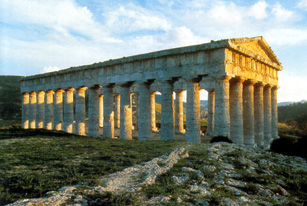 The origins
of Segesta are lost in the night of time.It was in continual conflict
with Selinunte for boundary questions, at the end Selinunte succumbed,
destroyed by Agatocle because it was part of the political sphere of
Carthage, rich in the Roman period because of the proximityof
Castellammmare, today it conserves the vestige of its ancient splendor
in an archaeological site that is still largely to be discovered . Among
the most beautiful finds that the ancient world has handed down to us,
is the Doric temple, datable to the early fifth century B.C., which
constitutes an authentic mystery for
The origins
of Segesta are lost in the night of time.It was in continual conflict
with Selinunte for boundary questions, at the end Selinunte succumbed,
destroyed by Agatocle because it was part of the political sphere of
Carthage, rich in the Roman period because of the proximityof
Castellammmare, today it conserves the vestige of its ancient splendor
in an archaeological site that is still largely to be discovered . Among
the most beautiful finds that the ancient world has handed down to us,
is the Doric temple, datable to the early fifth century B.C., which
constitutes an authentic mystery for
archaeologists, which rises intact against an uncontaminated landscape.
On the top of mount barbaro is the anphiteatre datable to the third
century B.C., where recent digs have brought to light a costume from
beneath the stage dating to the ninth-tenth century B.C.
 Erice Erice
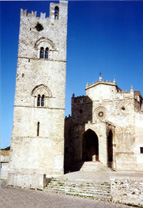 An important tourist and holiday centre on the top of an isolated
mountain . Founded on the site of the ancient Erice, religious centre of
the Elimi, famous for its temple to Venere Ericina. It was contested by
the Syracusani and the Carthaginians up to it being conquered by the
Romans. It was called Gebel Hamed during the Arab occupation, it
recovered some of its importance in XII century, and than followed the
political destiny of the island.
An important tourist and holiday centre on the top of an isolated
mountain . Founded on the site of the ancient Erice, religious centre of
the Elimi, famous for its temple to Venere Ericina. It was contested by
the Syracusani and the Carthaginians up to it being conquered by the
Romans. It was called Gebel Hamed during the Arab occupation, it
recovered some of its importance in XII century, and than followed the
political destiny of the island.
There is still a lot of medieval evidence and part of the ancient
monumental walls; the remarkable Chiesa Matrice (sixteent century)
dedicated to the assumption, the inside was reconstructed a century ago;
the medieval Castle (XII-XIII centure) with the remains of the temple
and the Municipal palace, seat of the library and the Cordici Museum,
with archaeological finds from the Erice necropolis, among which a head
of Afrodite of the fourth century B.C.
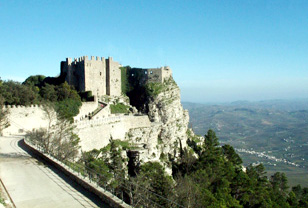
Its characteristic cobbled streets and narrow “Vanelle” (alleys) so
narrow that only one person can pass at a time (useful as a defence
during invasions). Apart from the typical cobbled streets are the
“Cortiletti”(courtyards) almost all of them full of plants and flowers
in an extraordinary choreography of colour and perfume, with the precise
function of giving space, air and living space to the Ericine families,
which following the example of the Arab families carried out various
activities in their courtyards. Today Erice hosts the international
centre of Scientific Culture Ettore Maiorana and internationally
important cultural manifestations. The Good Friday processio and the
procession of the “Personaggi” during the festival of Maria Santissima
of Custonaci are both of interest.
 Islands
and Marine Nature Reserve of The STAGNONE Islands
and Marine Nature Reserve of The STAGNONE
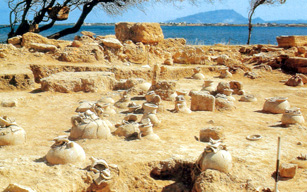 In
there centuries it managed to become one of the most florid Phoenician
colones of the In
there centuries it managed to become one of the most florid Phoenician
colones of the
Mediterranean. Due to the fortunate geographical position on the
commercial routes of the day and morphological circumstances ; the
laguna of the Stagnone protected between Isola Grande and the sicilian
coats supplied safe moorings. At the centre the island of St Pantaleo
offered further security.
It was here that the firts Phoenician colonists landed; the city grew to
such an extent that it became a nuisance to the Greeks, who led by
Dionisio II of Syracuse, destroyed it in 397 B.C. of the remains of
Mothia, the walls are visible, the tophet or sanctuary open to the sky
with the sacred enclosure for burials, and the dry dock (cathon). In the
museum founded by Whitaker are over 10,000 exhibits among which the
greek statue of the Auriga (5th century B.C.).
 Trapani Trapani
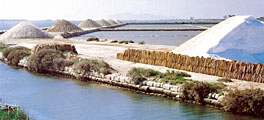 Provincial
county town, commercialand industrial centre with an active port. Of
ancient origins, it was Drepana to the Greeks because of its sythe shape,
then it was a Sicano village which depended on Erice, for which it was
the port. An important naval base and stronghold for the Carthaginian in
241 B.C. it was conquered by the Romans. From the middle ages to the
present day it has followed the destiny of the rest of Sicily. Formed by
an old part and a modern one, it still has a number of noteworthy
monuments such as the Basilica dell’Annunziata (14th century with a
precius 13th century statue of the Madonna and child), a portal by
Gagini and valuable railings, the church of Santa Maria di Gesu’ (15th
c) St Domenico, the Chiesa del Colleggio (17th c), the Cathedral (17th
c), St Agostino (14th c), the Chiesa del Purgatorio where the 20 sacred
groups of the Misteri of Trapani are housed, among the important
buildings are the town hall and the Casa Ciambra. Provincial
county town, commercialand industrial centre with an active port. Of
ancient origins, it was Drepana to the Greeks because of its sythe shape,
then it was a Sicano village which depended on Erice, for which it was
the port. An important naval base and stronghold for the Carthaginian in
241 B.C. it was conquered by the Romans. From the middle ages to the
present day it has followed the destiny of the rest of Sicily. Formed by
an old part and a modern one, it still has a number of noteworthy
monuments such as the Basilica dell’Annunziata (14th century with a
precius 13th century statue of the Madonna and child), a portal by
Gagini and valuable railings, the church of Santa Maria di Gesu’ (15th
c) St Domenico, the Chiesa del Colleggio (17th c), the Cathedral (17th
c), St Agostino (14th c), the Chiesa del Purgatorio where the 20 sacred
groups of the Misteri of Trapani are housed, among the important
buildings are the town hall and the Casa Ciambra.
Worth a visit is the Museo Nazionale Pepoli, which has collections of
archeology, sculpture, paintings and minor arts and the Biblioteca
Fardelliana. Also worth a visit is the fish market where the
caracteristic sale of fresh fish takes place amidst the shots of the
fishermen and the confusion of the crowds. A visit to the Nature Reserve
of the Saline, where the salt pans form an area where the sea mixes with
the land creating an environmental unicum of great cultural valency.
Among the important events is the procession of the 20 sacred groups of
the Misteri on Good Friday, the Luglio Musicale Trapanese and the
Festival of the Tuna Fish.
|